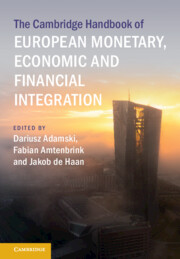Book contents
- The Cambridge Handbook of European Monetary, Economic and Financial Integration
- The Cambridge Handbook of European Monetary, Economic and Financial Integration
- Copyright page
- Contents
- Contributors
- Introduction
- Part I The Economic and Monetary Union
- Part II The Monetary Dimension
- 9 The Overburdened Monetary Policy Mandate of the ECB
- 10 Government Bond Buying by the European Central Bank
- 11 ECB Monetary Policies
- 12 From Market to Green Economics
- 13 The Politics of Monetary Union and the Democratic Legitimacy of the ECB as a Strategic Actor
- 14 How Can Courts Contribute to Accountability in EU Monetary Policy?
- Part III The Economic and Fiscal Dimensions
- Part IV Financial Integration
- Index
- References
9 - The Overburdened Monetary Policy Mandate of the ECB
from Part II - The Monetary Dimension
Published online by Cambridge University Press: 28 September 2023
- The Cambridge Handbook of European Monetary, Economic and Financial Integration
- The Cambridge Handbook of European Monetary, Economic and Financial Integration
- Copyright page
- Contents
- Contributors
- Introduction
- Part I The Economic and Monetary Union
- Part II The Monetary Dimension
- 9 The Overburdened Monetary Policy Mandate of the ECB
- 10 Government Bond Buying by the European Central Bank
- 11 ECB Monetary Policies
- 12 From Market to Green Economics
- 13 The Politics of Monetary Union and the Democratic Legitimacy of the ECB as a Strategic Actor
- 14 How Can Courts Contribute to Accountability in EU Monetary Policy?
- Part III The Economic and Fiscal Dimensions
- Part IV Financial Integration
- Index
- References
Summary
The ECB was designed as a monetary institution with a restrained mandate pivoting on its primary objective of price stability. However, during the sovereign debt crisis and the period of interest rates at the effective lower bound its restrained, market-oriented mandate changed profoundly. As implications of it going beyond price stability became increasingly important, the mandate of the ECB has been less restrained. This process helped achieve both its primary and secondary objectives in the environment of persistently low inflation. But, each time explained in terms of ‘monetary transmission mechanism’ and ‘singleness of the monetary policy’, monetary policy actions with serious implications for broader economic considerations have produced new risks and potential conflicts. The ECB has been forced to assume economic stabilization and anti-fragmentation functions in response to macroeconomic, fiscal, and financial centrifugal processes produced by national policies and design flaws of the single currency. In consequence, the euro area’s monetary policy has become overburdened by the task of mitigating consequences of actions beyond the control of the central bank, with potential negative effects both for its legitimacy and effectiveness.
- Type
- Chapter
- Information
- Publisher: Cambridge University PressPrint publication year: 2023
References
- 1
- Cited by

